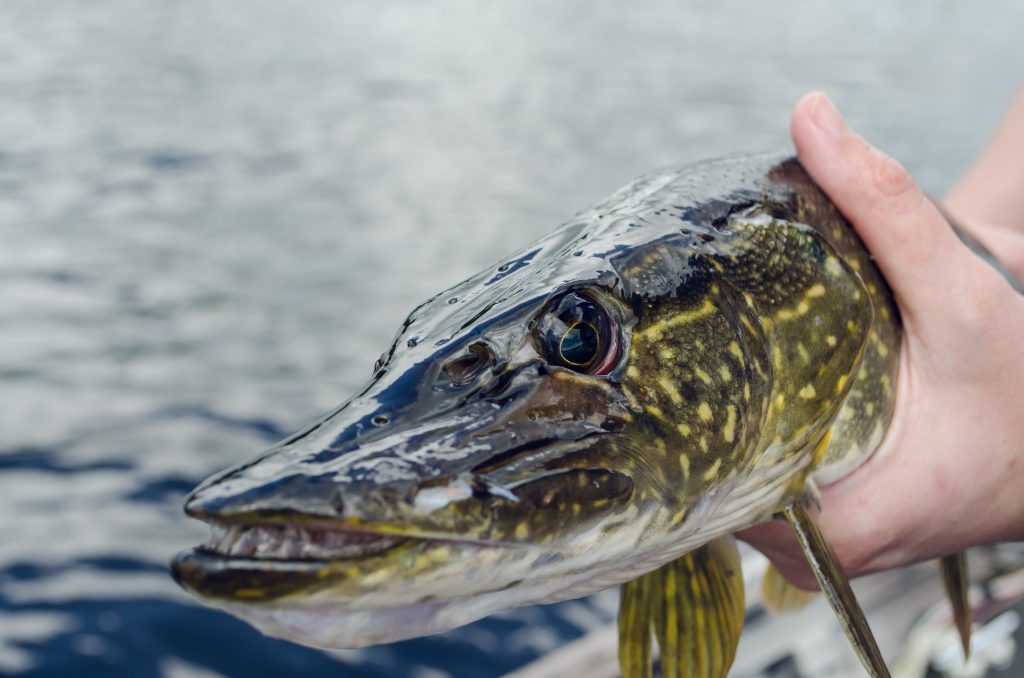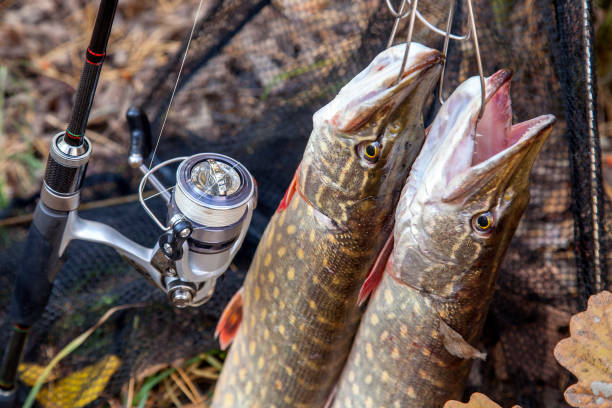Southern pike vs. northern pike in this blog you will know its facts and information. The Northern Pike is indeed a voracious fish found in Northern Hemisphere freshwaters. The Pike, hiding in the shadows and ready to strike its prey, demonstrates a brave attitude to nature.
A Northern Pike (Esox Lucius) receives its name from its resemblance to the Middle Ages’ pole-like weaponry known as a pike. Because of its predation status, it is a fish that little fish fear. The Northern Pike is one of the most exciting fish globally, and American Expedition is glad to share information and interesting facts about it.
When the water temperature reaches at least 48 degrees Fahrenheit in the spring, northern pike spawn. The male fertilizes the female’s eggs and spreads them on plants in water no more profound than a foot deep. In most cases, between 15,000 and 75,000 eggs are laid. Both males and females leave when the sticky eggs adhere to the submerged vegetation.
After around two weeks, the eggs hatch. The newly hatched “fry” eat their egg sack until it is gone, then switch to zooplankton for the rest of their lives. They start eating small fish after around two weeks. The first two years of a pike’s life grow the fastest. Between the ages of 3 and 5, males and females reach sexual maturity, with males reaching it earlier than girls of the same period. In the wild, the typical lifespan of a northern pike is seven years.
Facts about Northern Pike

- The Northern Pike is the state fish of North Dakota.
- American Pike, common Pike, Great Lakes pike, jackfish, long head, and snot rocket are other names given to the Northern Pike.
- Ambush predators, Pike, are well-known.
- Pike has a remarkable ability to lie still for long periods.
- Northern Pike can swim at speeds of up to ten miles per hour.
- The fish becomes more extensive as it gets older.
- The majority of Pike over 18 pounds are female.
- Germany holds the world record for Pike.
- Pike do not lay their eggs in nests.
- The eggs are not cared for by either the male or female Pike once they have been laid.
- The bulk of the fry does not survive the hatching process.
- Because of a sticky patch on their heads, the “fries” continue to cling to foliage. This patch hangs around for a few weeks.
- The eldest Pike lived to reach 25 years old in its natural habitat.
- The Pike isn’t picky about what it eats.
- Humans are usually the only predators of adult pike.
Habitat of Northern Pike

Southern pike vs. northern pike, Northern pike-like densely vegetated environments such as streams, lakes, and major rivers. They prefer to occupy shallow waters along the shore to find cover. They enjoy chilly water and will migrate to deeper water in the middle of the summer.
Northern Pike: What Do They Eat?
Pike are predatory fish that eat a lot of food daily. Their food consists primarily of smaller fish, consuming frogs and birds. Pike lurk in the undergrowth, motionless, waiting for a prey to approach close enough to strike. Pike aren’t picky about what kind of fish they consume; they’ll eat anything smaller than them.
Fishing Techniques for Northern Pike

- Pike are famous among anglers because of their fighting ability, the delicious flavor of their cooked flesh, and their ease of capture.
- A pike’s meat is white and flaky, but it’s also rather boney.
- Cast at the water’s edge, near or in weed beds, or near a rocky beach.
- Pike will attack almost anything that moves. As a result, the type of lure you select will have little impact on the outcome of your fishing trip.
- Use a lure that is simple to take out of the fish’s mouth.
- A spoon is the most popular bait for catching Northern Pike.
- Surface fishing with jitterbug lures is a good idea.
- Choose a fishing reel with which you are most comfortable. For a beginner, the spin cast reel is the most user-friendly.
- Pike are more active during the day than at night.
- Bobber fishing is another method of catching Pike. Cast the hook along the shore with a shad, a minnow, or perhaps bluegill attached.
- Northern Pike is a popular target for bow fishers.
- Fishing rules differ from state to state. Before heading out to fish, you should familiarize yourself with them.
- If you’re going to start fishing, make sure you get a permit first. Overfishing without the need for a license is punishable by a fine. Many states don’t require a fishing license for young children or veterans.
- Some fish do not have a year-round open season, even though many do. To figure out until you’ve authorized to fish, check your state’s regulations.
- The majority of states have a fish length limit. If somehow the fish you captured does not meet the minimum size requirements, you must release it. There are also sometimes maximum limitations for specific fish.
- Most states also impose daily limitations on the amount of fish caught in a single day.
What’s the Difference Between Southern Pike vs. Northern Pike?
Southern pike vs. northern pike, if you’re a North American pike angler, this may appear to be a comedy of a question. I’d never remembered hearing of a Southern Pike till a few weeks earlier, and I mistook it for a strange local language for chain pickerel, North America’s main pike look-alike.
It’s tough to tell the difference between the ordinary northern Pike (found throughout Europe) and the southern Pike, and there’s a reason for it.
The southern Pike is a cousin of the Northern Pike, only found in Europe. They weren’t designated a separate Essex family member until 2011, demonstrating how closely they are related to northern pike.
Researchers had to conduct extensive research to determine that the southern Pike wasn’t just a northern pike with a distinct coloration but that it had evolved sufficiently over time to be recognized as a separate species.
As a result, the Essex family has a new member.
Pike (Northern) vs. Pike (Southern): A European Debate
Southern pike vs. northern pike, this isn’t going to be your typical comparison post where you compare two species and illustrate the similarities and differences. There hasn’t been much research comparing and contrasting the two species because the southern Pike wasn’t classified as a different species until 2011.
Italy is home to the vast majority of southern pike species. Small numbers have been reported in the southernmost Alps of Switzerland and on the fringe of the Balkans, but this is primarily an Italian Pike (and that is likely to be a nickname that eventually sticks).
Southern Pike is unique in that they have four distinct patterns instead of the single pattern found in northern Pike.
Southern Pike will resemble northern Pike in appearance and behavior. They will remain in the Esox family, having originated as the same fish species like Pike north before splitting off and changing over time.
Whereas the unofficial southern pike record is 22 pounds, there’s no reason why this Pike couldn’t grow to be approximately the same size as its northern pike kin in the exact location given the appropriate conditions.
There will undoubtedly be further investigation into this, as there is a risk of hybrid if the south and northern Pike are placed in the same water. The trouble with hybridization is that they are almost always infertile.
If an increasing population of fish is unable to reproduce, it may threaten both species of fish in those waterways, particularly in the long run.
As a result, this differentiation is critical, particularly in pike-rich Italian waters.
Why haven’t You come across a Southern Pike before?
The most obvious explanation is that the officially acknowledged southern Pike is now only nine years old as of this blog article! What exactly does that imply?
The southern Pike was not consider a separate species until 2011. This was only a “slight variation” of the northern European Pike. For a long time, there was no cause to contest this.
There were signs that it was a different species. Although there were varied side patterns and habitats, much physical aggression was present.
The Southern Pike is a European species of fish
Another factor could be that the famous southern Pike’s habitat is quite limited, as mentioned a little earlier. This is not just a European pike, but the new one is nearly entirely focus on Italy, with maybe minor numbers in the southernmost region of Switzerland and the outer/coastal Balkans.
As a result, many anglers were utterly unaware of the shift.
Why would you go fishing in Italy unless your fishing adventures take you there? Anglers were hoping to catch every variety of Esox or members of the pike family, on the other hand, will find things intriguing.
Because you recognize a northern pike when you see one, E on the chart below will look recognizable. However, A-D, whose patterns range from musky-like to pickerel-like, are all frequent designs found on various southern pikes.
Biological vs. Fisherman Southern Pike
For the most part, anglers in the area haven’t noticed much difference. If you went pike fishing in Italy before 2011, you were probably going after the now-famous southern Pike, regardless of what the name was.
The southern Pike is recognize as a new fish because there are enough genetic and morphological differences to tell biologists that this wasn’t a northern pike. It was distinct enough to be consider a separate species.
As a result, there is no discernible shift among anglers.
This distinction is critical for regulating the stocking of these popular sporting fish throughout Italy. While a hybrid might be a fun not-so-little catch, its failure to breed can have a long-term negative impact on the quantity of Pike in a given area.
Future research on the southern Pike, on the other hand, will be more fascinating as a result of this. When will they be officially acknowledge as sports anglers? How distinct will various populations become, particularly outside of Italy?
Something to keep an eye on, particularly if you’re curious about the variations between northern and southern Pike.
Chain Pickerel vs. Northern Pike
There are several evident differences if the north pike vs. south pike debate is based in the United States and refers to the related Esox of the chain pickerel. We won’t spend too much time on this because we’ve already covered how to discern the difference between Pike and pickerel in another blog post.
The chain pickerel is the most frequently mistaken for a little midsize or medium-sized pike in the United States. They are not just a southern pike, and they’re the Pike’s Esox relative, which is often found in the south.
The Differences Between Pike and Pickerel in Bullet Points
- Underneath the eye, there is a teardrop design (narrow vertical for Pike, wide-angled for pickerel)
- All fish over 10 pounds are consider Pike.
- The pattern on the side
- Spots on the fins indicate pike.
- Differences in color (yellow vs. green)
- Pores on the underside of the jaw
If the pickerel were wrongly identified as southern Pike. It wouldn’t take long to tell the two differences in most situations. Knowing what to look for each base species can successfully identify even mixtures.
Southern Pike Frequently Asked Questions
Q: How different is the southern Pike from the northern pike?
A: There will not be much of a difference from the angler’s perspective. If you were pike fishing in Europe before 2011 and after 2011, you probably didn’t notice much difference due to the different species.
From the perspective of a scientist or those in charge of fish stocking, this is critical because intermixing northern and southern Pike can result in hybrids in the wild, which can harm both fish’s long-term health because combinations are unable to spawn naturally.
Q: What exactly do we know about the Southern Pike?
A: This is one of those responses that sound contradictory at first, but it’s “a lot, yet not a lot.” Because the southern Pike is a newly recognize species. There is a lot of overlap between the northern Pike caught in Italy and those that would now be classified as south Pike.
As a result, different numbers and information on the species can vary significantly over time.
Q: What is the maximum size of a northern pike, European Pike, or southern Pike?
A: The numbers change depending on the Pike and the location. Northern pike world records typically range from 40 to 50 pounds in North America, up to 50 pounds in Europe and Russia, and a little more than 20 pounds for southern Pike. Though this last number is expect to change dramatically over time, more attention is paid to South Pike as a distinct species.
Q: What is the most significant distinction between the various southern and northern pike designs?
A: Southern Pike has a variety of lines and patterns that can run horizontally or vertically. On the other hand, the northern Pike’s designs will be distinct dots rather than kin, and the way will flow horizontally from left to right rather than vertically up and down.
Q: What clues did you have that the southern and northern Pike were two different species?
A: The number of scales along the lateral line in the two species differs significantly. For these scales, the northern Pike’s range is 125 to 148, while the southern Pike’s content is 101 to 115.
Q: Do southern Pike have the same dotted pattern as northern Pike at times?
A: No way. Northern Pike has a characteristic dotted pattern, while southern Pike has not.
Final Thoughts
It will be fascinating to see whether anglers or other local fishing guides provide additional information on the southern pike vs. northern pike in the coming years. Local fishermen refer to it as “pike fishing” in many places because there is no discernible difference between them.
After all, what does it matter if some of the local pikes have a little different name now if they’ve spent decades fishing for them? Same struggle, same delectable flavor, same enjoyable time on the water.
A good pike is a good pike, whether it’s the northern Pike, which can found in all north of climates across the world, or the southern Pike. Which can only found in Italy and a few other places in Europe.
While this is a fascinating comparison between the two species, pike fishing is fun no matter where you go. Now you know the facts and information of southern pike vs. northern pike.


